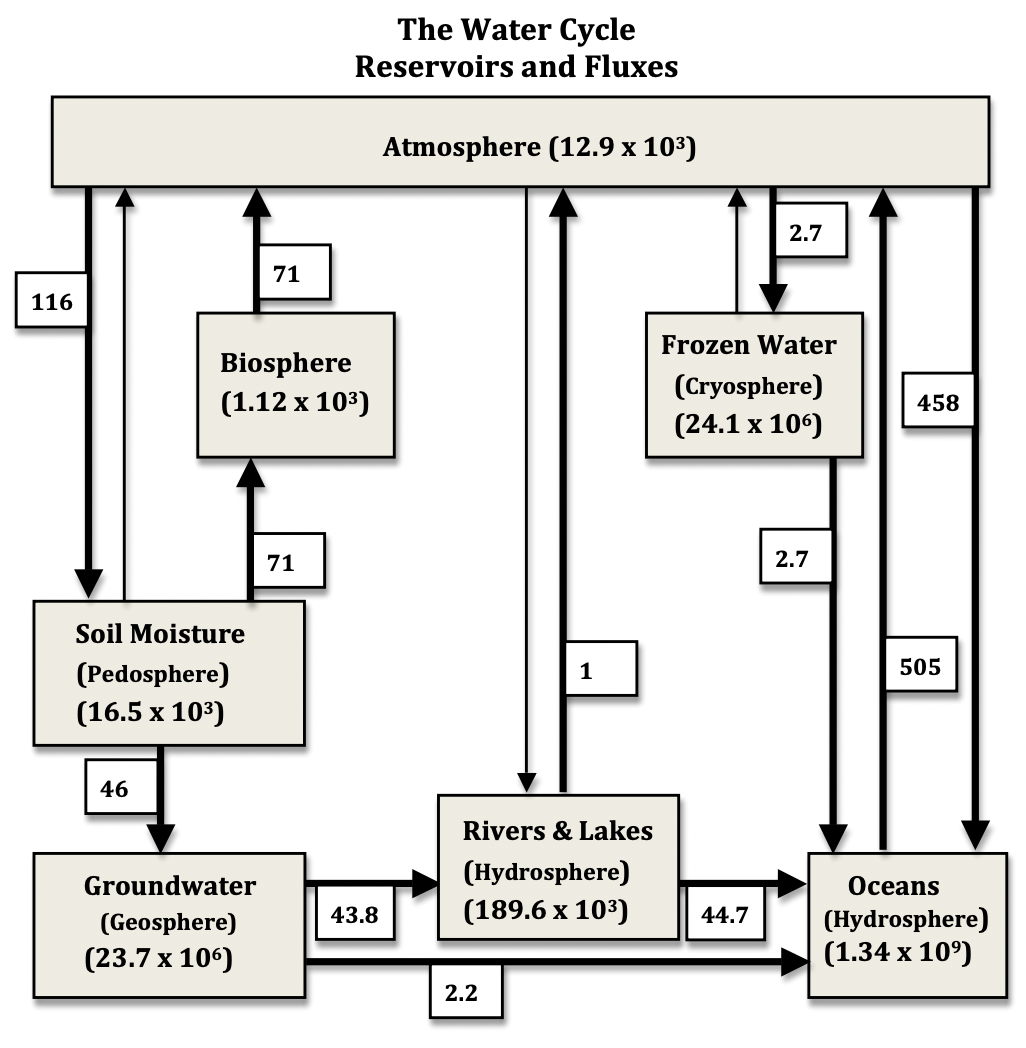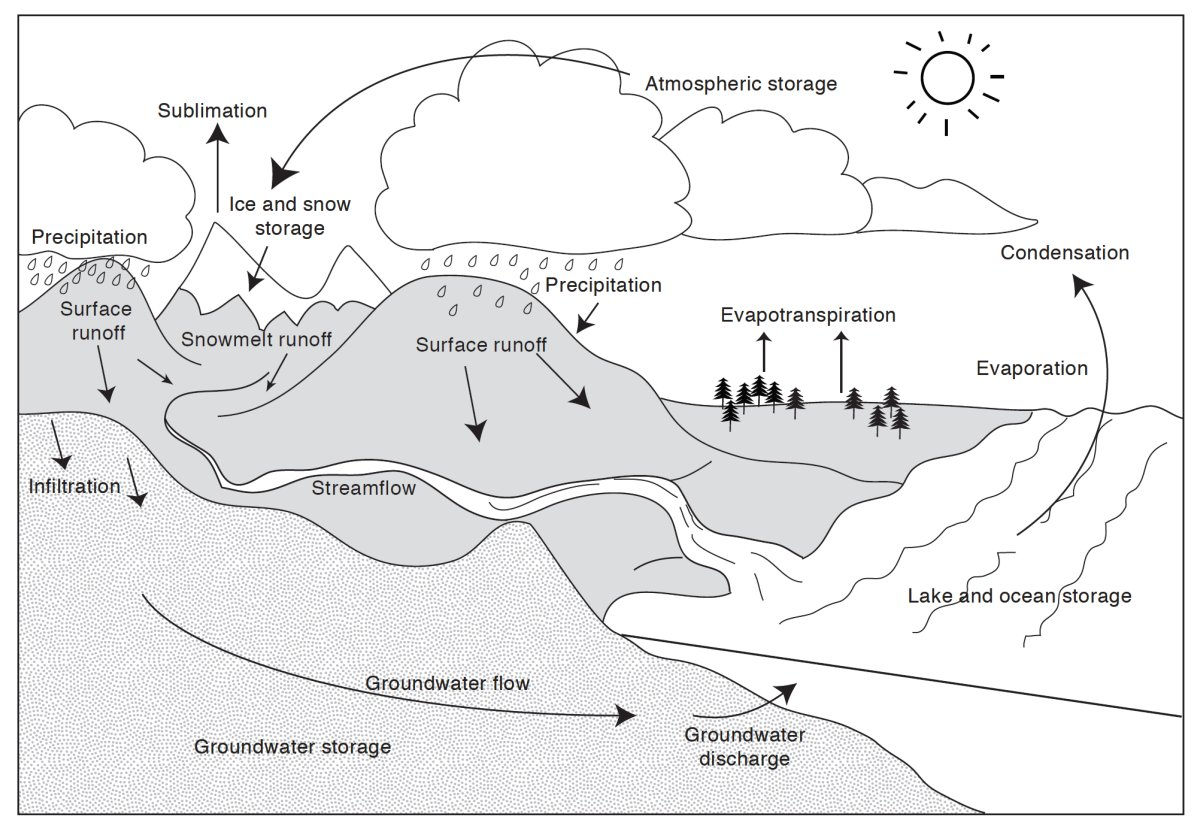IB Syllabus focus:
‘The water cycle functions as a system; diagrams show stores as boxes and flows as arrows to visualise transfers and transformations.’
The hydrological cycle is a global system that connects water stores and flows, driving the movement and transformation of water across Earth’s atmosphere, land, and oceans.
The Hydrological Cycle as a System
The hydrological cycle can be understood as a closed system at the planetary scale, where water is neither created nor destroyed but continuously cycled. Within this global cycle, it is helpful to view it as an open system at regional or local scales, where water enters and leaves boundaries through processes like precipitation and runoff.
System Components
Inputs: Processes such as precipitation add water to a system.
Outputs: Processes like evaporation, transpiration, and runoff remove water.
Stores: Reservoirs where water is held temporarily, such as oceans, glaciers, and groundwater.
Flows: Movements of water between stores, such as infiltration, condensation, and percolation.
System: A set of components that interact with each other to form a functioning whole, with inputs, outputs, stores, and flows.
This systemic view enables environmental scientists to understand both the stability and vulnerability of water resources.
Stores of Water
Water stores act as boxes in a hydrological system diagram. They vary greatly in size and longevity.

A box-and-arrow systems diagram of the hydrological cycle showing the principal stores (atmosphere, cryosphere, soil moisture, groundwater, rivers & lakes, oceans, biosphere) and the connecting flows. This visual aligns with the IB requirement to depict stores as boxes and flows as arrows to illustrate transfers/transformations. Note: flux values are included for completeness and exceed the detail typically required at SL. Source.
Major Stores
Oceans: Contain the largest proportion of global water, forming the primary long-term store.
Cryosphere (glaciers and ice caps): Large frozen reserves of freshwater, slowly releasing meltwater.
Groundwater: Subsurface reservoirs that supply aquifers, essential for long-term freshwater storage.
Surface water: Rivers, lakes, and wetlands, which represent dynamic, short-term storage.
Atmosphere: Holds water vapour, clouds, and precipitation; though small in volume, this store drives climatic patterns.
Biosphere: Plants and animals contain small amounts of water, important for transpiration and ecological functioning.
Store: A location where water is held for a period of time before being transferred by flows.
Though oceans dominate in volume, smaller stores such as soil moisture and groundwater are critical for sustaining ecosystems and human societies.
Flows in the Cycle
Flows are represented as arrows in diagrams of the hydrological system. They link stores and illustrate the transfer or transformation of water.

A labelled hydrological-cycle schematic illustrating how arrows trace flows between major stores such as the atmosphere, surface waters, ice/snow, and groundwater. The diagram emphasises transfers (runoff, streamflow, groundwater flow) and transformations (evaporation, condensation) at an appropriate SL level. Labels are concise and the layout is uncluttered for rapid comprehension. Source.
Key Flows
Precipitation: Water released from the atmosphere as rain, snow, or hail.
Evaporation: Transformation of liquid water into water vapour due to solar energy.
Transpiration: Water loss from plants through stomata, contributing to atmospheric vapour.
Condensation: Transformation of vapour to liquid, forming clouds and droplets.
Runoff: Movement of water across the land surface into rivers and lakes.
Infiltration: Entry of water into soil pores.
Percolation: Downward movement of water through soil into underlying rock layers.
Streamflow: Flow of water within rivers and streams towards the sea.
Groundwater flow: Slow lateral movement of subsurface water towards discharge points.
Flow: The movement of water from one store to another, involving either a transfer (movement) or transformation (change of state).
These flows vary in scale and speed, with some occurring rapidly (surface runoff) and others slowly (groundwater flow).
Transfers and Transformations
The hydrological cycle involves two key types of processes:
Transfers
These are movements of water without changing its state.
Examples: Infiltration, percolation, runoff, streamflow, advection (wind-driven vapour movement).
Transformations
These involve changes in the physical state of water.
Examples: Evaporation (liquid to vapour), condensation (vapour to liquid), sublimation (solid to vapour).
Sublimation: Direct transformation of ice into water vapour without becoming liquid.
Transfers and transformations ensure the continuous circulation of water across stores.
Visualising the Hydrological Cycle
The IB syllabus highlights that the hydrological cycle is often represented diagrammatically:
Boxes: Represent water stores (oceans, glaciers, groundwater, etc.).
Arrows: Represent flows and transformations (precipitation, evaporation, infiltration).
Diagrams help to show the scale and interconnection of processes.
Visual models make it easier to compare different ecosystems, identify imbalances, and understand human impacts such as land-use change, water abstraction, or climate variability.
Systems Thinking in Hydrology
Viewing the hydrological cycle as a system supports analysis of sustainability and resource management. For example:
Steady state equilibrium occurs when inflows equal outflows, maintaining storage levels.
Dynamic equilibrium reflects natural variability in inputs and outputs while preserving long-term stability.
Disruption occurs when flows are altered beyond recovery, such as through over-abstraction of groundwater or rapid glacier melt.
Understanding these systemic relationships allows decision-makers to predict how changes in one part of the system may cascade through others, highlighting the importance of integrated water management.
FAQ
Globally, the hydrological cycle is a closed system because no water enters or leaves Earth—it is continuously recycled.
At regional or local scales, however, it acts as an open system, as precipitation can enter, and runoff or evaporation can leave specific areas. This dual perspective helps analyse both global balance and local water resource challenges.
Water flows and stores influence temperature and weather patterns.
Evaporation and transpiration transfer heat into the atmosphere as latent energy.
Condensation releases heat, driving atmospheric circulation.
Ocean storage regulates global heat, acting as a buffer for climate stability.
Vegetation connects the biosphere to atmospheric and soil water.
Roots increase infiltration and percolation.
Leaves drive transpiration, contributing to atmospheric moisture.
Canopy cover reduces surface runoff by intercepting rainfall.
Thus, vegetation regulates both the quantity and timing of water movement.
Although it contains a tiny fraction of Earth’s water, the atmosphere drives short-term variability.
Vapour transport (advection) moves moisture between regions.
Cloud formation through condensation determines rainfall distribution.
Its rapid turnover ensures constant renewal of freshwater inputs.
Transfers and transformations highlight different system functions.
Transfers (e.g., runoff, infiltration) show how water moves physically.
Transformations (e.g., evaporation, condensation, sublimation) reveal energy-driven state changes.
Distinguishing them helps evaluate human impacts, such as reduced infiltration from urbanisation versus altered evaporation due to deforestation.
Practice Questions
Question 1 (2 marks)
Define the terms store and flow in the context of the hydrological cycle.
Mark scheme:
Store: A location where water is held for a period of time before transfer. (1 mark)
Flow: The movement of water from one store to another, either as a transfer or transformation. (1 mark)
Question 2 (5 marks)
Using a systems approach, explain how stores and flows interact to maintain the hydrological cycle.
Mark scheme:
Recognition that the hydrological cycle functions as a system with inputs, outputs, stores, and flows. (1 mark)
Description of at least two major stores (e.g., oceans, groundwater, cryosphere, atmosphere). (1–2 marks)
Explanation of key flows linking stores, such as evaporation, precipitation, infiltration, runoff, condensation. (1–2 marks)
Clear explanation of how flows maintain transfers between stores, sustaining the overall system. (1 mark)
Maximum: 5 marks

